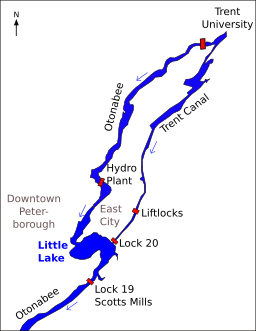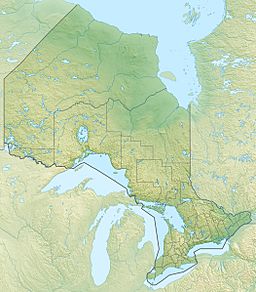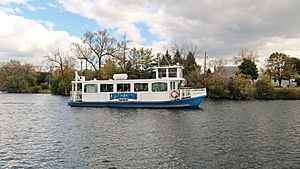Little Lake (Peterborough) facts for kids
Quick facts for kids Little Lake |
|
|---|---|

The fountain in Little Lake
|
|
 |
|
| Location | Peterborough, Ontario, Canada |
| Coordinates | 44°17′47″N 78°18′37″W / 44.2964916°N 78.310271°W |
| Type | Lake |
| Part of | Trent–Severn Waterway |
| Primary inflows | Otonabee River, Jackson creek, Trent Canal |
| Primary outflows | Otonabee River |
| Basin countries | Canada |
| Surface area | 64 hectares (160 acres) |
Little Lake is a small lake in Peterborough, Ontario, Canada. It's right in the middle of the city! The lake is part of the Otonabee River. People use Little Lake for fishing, swimming, and boating. Many fun events also happen here. This lake is an important stop on the water route from Lake Ontario to the Kawartha Lakes.
European settlers first came to this area around the early 1800s. Back then, sawmills used the lake and river to prepare wood. Sadly, sawdust and waste from the mills polluted the lake. This pollution harmed the fish and made it hard for boats to pass. The bad smell even made some people move away.
By the end of the 1800s, these problems were solved. Little Lake then became a key part of the new Trent–Severn Waterway. This waterway connects Lake Ontario to Lake Huron. Later, factories like General Electric used the lake to get rid of their waste chemicals. Most of these chemicals are now stuck in the mud at the bottom. Today, the lake is safe for everyone to enjoy.
Contents
Where is Little Lake Located?
Peterborough is about 50 kilometres (31 mi) north of Lake Ontario. It is also south of the beautiful Kawartha Lakes. The Otonabee River flows from the Kawartha Lakes through Peterborough. At Little Lake, the Jackson Creek joins the Otonabee. The river then continues south to Rice Lake. From Rice Lake, the Trent River flows into Lake Ontario.
The Otonabee River drops about 144 feet (44 m) from Katchewanooka Lake to Little Lake. The Trent Canal runs next to the Otonabee River. It leaves the river upstream from Little Lake and then rejoins it in the lake. Because the Otonabee is to the west and the canal is to the east, the East City part of Peterborough is like an island!
Little Lake was formed naturally during the last ice age. It covers an area of about 64 hectares (160 acres). The land around the lake is used for homes, businesses, and parks. The Little Lake Cemetery is also nearby. It extends into the south end of the lake.
Fun Things to Do at Little Lake
Little Lake is a great place for many activities. You can go swimming, fishing, or boating. All kinds of boats use the lake, including power boats, kayaks, canoes, and windsurfers. If you like fishing, you might catch bass, walleye, perch, or muskie.
There is a small marina in downtown Peterborough. It has 92 spots where boats can dock. You can moor your boat there for a day, a week, or even a whole season. The city runs this marina. The Otonabee River brings about 55 cubic metres per second (1,900 cu ft/s) of water into the lake at Crary Park Marina. Jackson Creek adds another 20 cubic metres per second (710 cu ft/s).
The lake also hosts many special events. These include wakeboarding shows, dragon boat races, the Peterborough triathlon, and the Festival of Lights.
Parks Around Little Lake
Several city parks are located around Little Lake. These include Beavermead Park (52.6 acres (21.3 ha)), Roger’s Cove Park (7.6 acres (3.1 ha)), Del Crary Park (8.2 acres (3.3 ha)), Millennium Park (4.5 acres (1.8 ha)), and James Stevenson Park (13.3 acres (5.4 ha)).
Del Crary Park has an outdoor stage for performances. It's right next to the Art Gallery of Peterborough. Beavermead Park was once owned by John A. Macdonald. He was Canada's first Prime Minister! The park gets its name from Beaver Creek and Meades Creek, which flow through it.
Little Lake's Past
It is believed that Samuel de Champlain launched his canoe in Little Lake. He then traveled down to Rice Lake and the Trent River. In 1818, Adam Scott built a sawmill and grist-mill on the south side of Little Lake. This area, called Scott Plains, eventually grew into the city of Peterborough.
The first British settlers arrived in the early 1800s. They traveled to Rice Lake, then up the Otonabee River to Scott's Plains. From Little Lake, they could reach the Kawarthas. They either continued up the Otonabee past Lakefield or carried their canoes northwest to Chemong Lake.
In the 1820s, the Otonabee River was shallow near Little Lake. People could even walk across it! Later, surveys were done for the Trent–Severn Waterway. This project aimed to connect Lake Huron to Lake Ontario. Locks were built at places like Bobcaygeon, Little Lake, Hastings, and Chisholm Rapids. Work on a dam and lock at Whitla's Rapids began in 1837. This lock, now called Scott's Mills lock, helped steamers reach Little Lake.
The Little Lake Cemetery was started in 1850. It was built on a piece of land sticking out into the lake.
Canoes and Lumber
John Stephenson was one of the first people to build canoes in the Peterborough area. He built them from planks and ribs, not just birchbark. In 1857, he watched a boat race on Little Lake. He noticed how hard it was to carry the heavy dugout canoes. The next year, he built a lighter, faster canoe.
The 1800s saw a huge lumber industry around the Kawartha Lakes. Mills used dams and chutes to float wood down to Lake Ontario. From there, the wood was shipped to England and other parts of Europe. Many large sawmills operated around Little Lake. The Nassau Mill, upstream from Peterborough, was one of the biggest. It could cut 90,000 feet (27,000 m) of wood in just twelve hours!
These sawmills dumped sawdust and other waste into the river. This made it hard for boats to move and killed many fish. Atlantic salmon, which used to be common, disappeared completely. The bad smells from the decaying wood and dead fish forced people living near Little Lake to move. By the 1870s, the pollution was finally controlled. The Ontario government made sawmills burn their sawdust instead of dumping it.
In 1887, the Mayor of Peterborough asked the Canadian government to clean up Little Lake. The lake had filled with sawdust and waste from the mills over 40 years. The lake was about 1⁄3 of a mile (0.5 km) wide. It used to be 6 to 10 feet (1.8 to 3.0 m) deep.
Connecting the Otonabee River from Little Lake to Lakefield was a big topic in the 1890s. This would create a continuous waterway. The plan involved building dams and locks on the river. A canal was dug from Nassau to Little Lake. A dam was built across the river at Nassau. The canal led to the famous Peterborough Lift Lock, and then to another lock where it enters Little Lake.
The Centennial Fountain was built to celebrate Canada's 100th birthday. It shoots water 76 metres (249 ft) high! This makes it the tallest jet fountain in Canada.
Keeping Little Lake's Water Clean
In the early 1900s, many big factories moved to Peterborough. They wanted to use the hydroelectric power from stations built near Little Lake. These companies included Johnson Motor Company, Canadian General Electric, and Quaker Oats. Sadly, some industries put their waste into the river. By 1930, people knew that Little Lake was polluted with chemicals. This pollution caused many fish in the river to die.
A study in 1989 found that Little Lake, the Otonabee River, and Rice Lake had some pollution. It showed that polychlorinated biphenyl (PCB) chemicals were not fully trapped in the mud as thought. Because Little Lake is shallow, polluted mud can easily be washed downstream.
Good news! PCB levels have been checked for over 30 years. They have been going down in Little Lake and the Trent–Severn Waterway. In March 2018, a pipe from the GE factory accidentally leaked some chemicals into the lake. However, in June 2018, the Peterborough Public Health department said it was safe to swim and catch fish in the lake. Most of the pollution is believed to be in the mud at the bottom. This means it won't affect people using the lake for fun.




